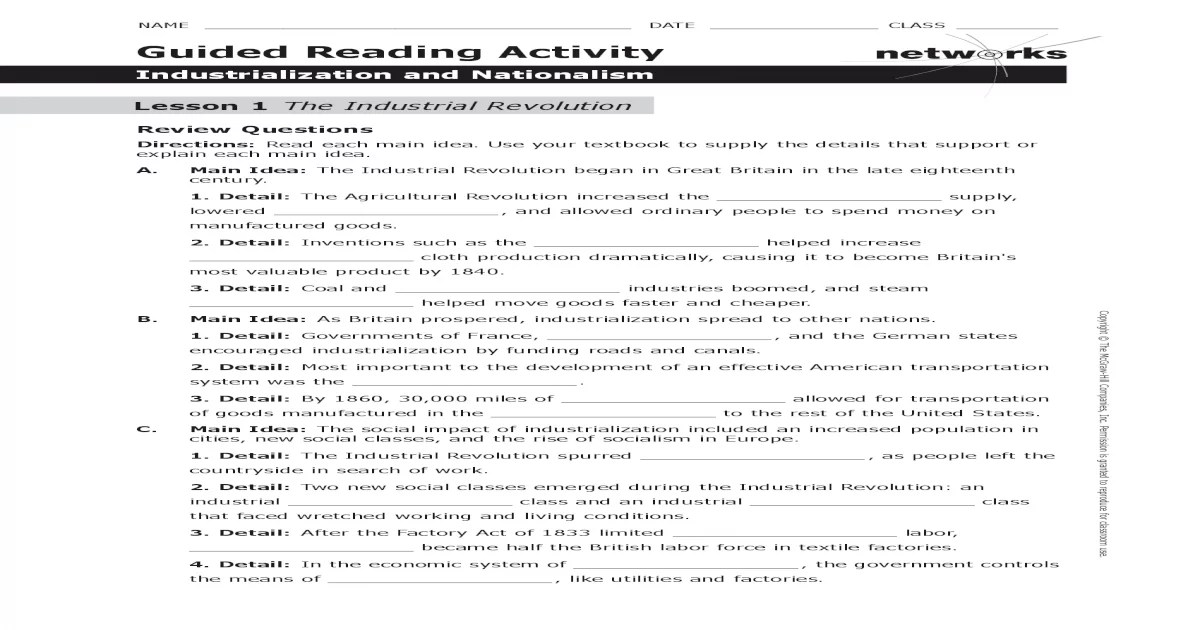With Answer Key Networks Guided Reading Activity Lesson 3 Answers at the helm, we embark on an enlightening journey that unravels the significance of these networks in guided reading. Guided reading, a pedagogical approach that empowers students in their literacy development, finds a steadfast companion in answer key networks, offering a structured framework for enhancing comprehension and critical thinking.
Lesson 3, an integral part of this guided reading adventure, presents a unique set of objectives that aim to refine students’ reading comprehension skills. Answer key networks, meticulously crafted to align with these objectives, serve as a guiding light, illuminating the path to deeper understanding and meaningful engagement with the text.
Answer Key Networks in Guided Reading Activities: Enhancing Literacy Skills

Guided Reading activities play a crucial role in developing students’ literacy skills. Answer Key Networks (AKNs) serve as valuable tools within these activities, providing students with targeted support and guidance as they navigate complex texts.
Key Concepts
AKNs are structured sets of questions and prompts that help students engage with the text and comprehend its content. By using AKNs, students can identify key concepts, make inferences, and develop critical thinking skills.
Guided Reading activities are designed to support students as they progress through different levels of reading proficiency. Lesson 3 focuses on building students’ ability to analyze and interpret complex texts.
Answer Key Networks: Implementation, Answer key networks guided reading activity lesson 3 answers
AKNs in Lesson 3 can take various forms, such as multiple-choice questions, open-ended prompts, or graphic organizers. These tools can be integrated into the lesson through:
- Pre-reading: To activate prior knowledge and set reading goals.
- During reading: To guide students’ understanding and facilitate comprehension.
- Post-reading: To assess students’ understanding and reinforce key concepts.
Ensuring student engagement with AKNs involves:
- Providing clear instructions and modeling their use.
- Creating AKNs that are relevant and challenging.
- Providing timely feedback and support.
Analysis of Lesson 3 Answers
| Question | Answer |
|---|---|
| What is the main idea of the text? | The importance of collaboration in achieving success. |
| Identify three supporting details. | – Teamwork allows individuals to share ideas and perspectives.
|
Commonalities in the answers include a clear understanding of the main idea and the ability to provide relevant supporting details.
Lesson Improvement
Alternative AKNs for Lesson 3 could include:
- A Venn diagram comparing the benefits of individual work and collaboration.
- A role-playing activity where students simulate a collaborative project.
- A debate on the importance of collaboration in various fields.
To enhance the use of AKNs in Lesson 3, consider:
- Providing more opportunities for students to work collaboratively on AKNs.
- Differentiating AKNs to meet the needs of diverse learners.
- Using technology to create interactive AKNs.
Recommendations for improving the Guided Reading Activity:
- Incorporate more hands-on activities to engage students.
- Provide explicit instruction on comprehension strategies.
- Monitor student progress and adjust instruction accordingly.
Additional Resources
- AKNs in Guided Reading: A Practical Guide
- Best Practices for Using Answer Key Networks
- Research on the Impact of Answer Key Networks
Helpful Answers: Answer Key Networks Guided Reading Activity Lesson 3 Answers
What is the significance of Answer Key Networks in Guided Reading?
Answer Key Networks provide a structured framework that supports students in developing comprehension skills, critical thinking, and a deeper understanding of the text.
How can Answer Key Networks be integrated into Lesson 3?
Answer Key Networks can be integrated into Lesson 3 through various methods, such as providing students with a set of questions and answers, using them as a reference during group discussions, or incorporating them into interactive activities.
What strategies can be used to ensure student engagement with Answer Key Networks?
To ensure student engagement, teachers can employ strategies such as gamification, incorporating multimedia elements, and providing opportunities for students to create their own answer key networks.